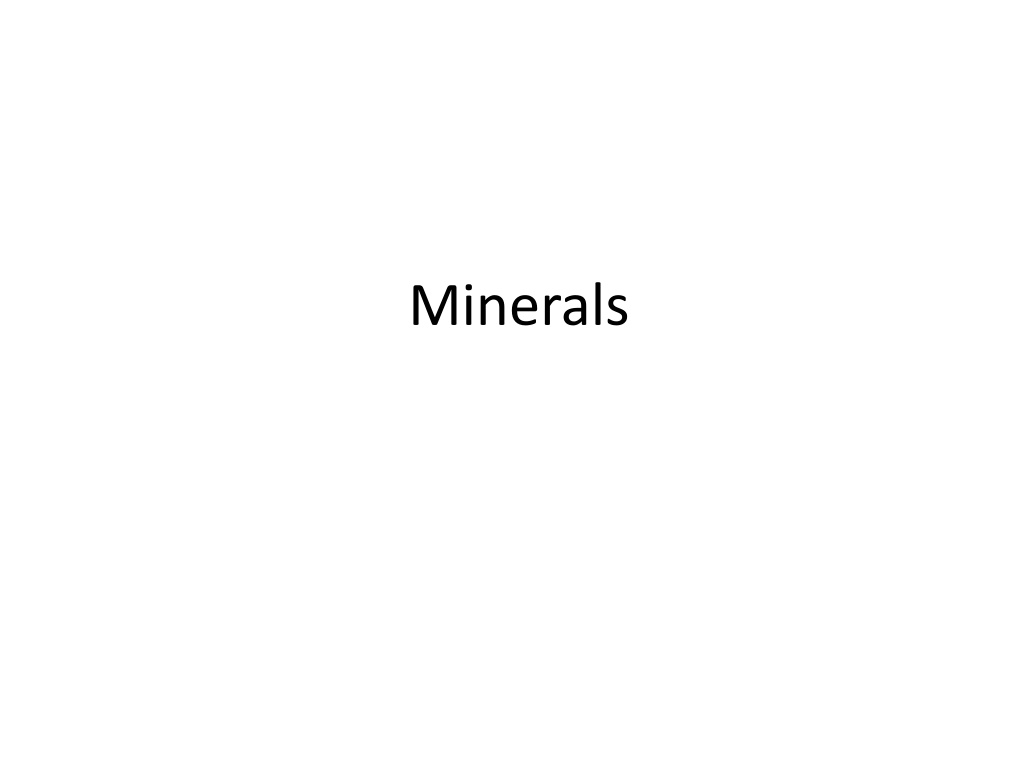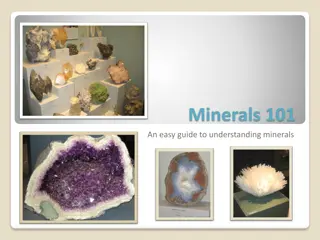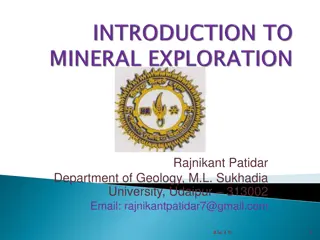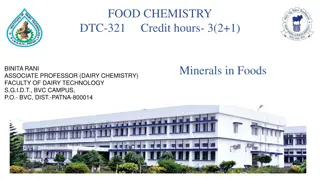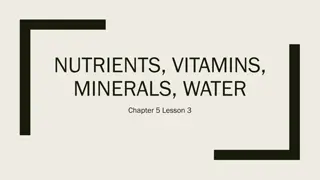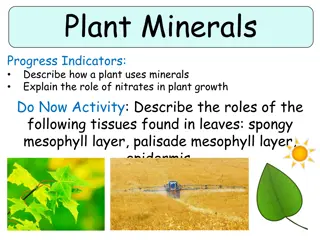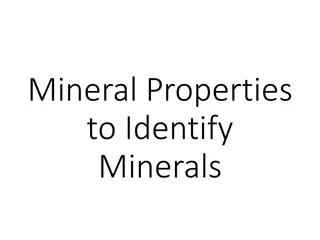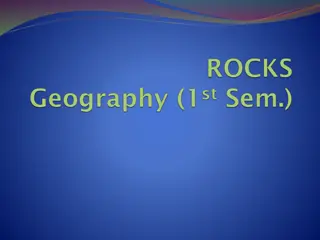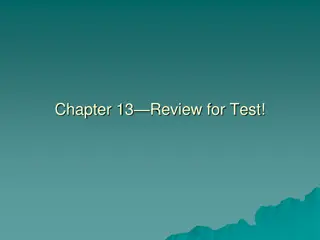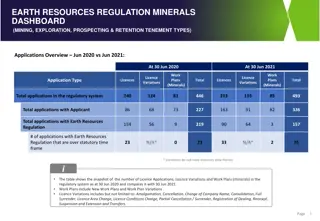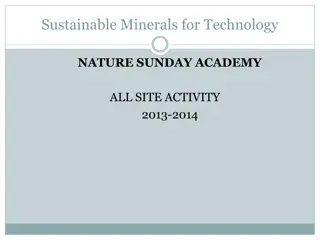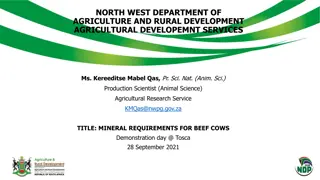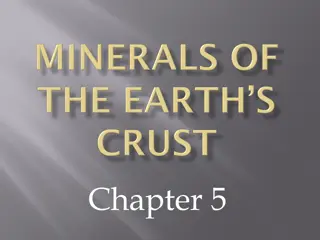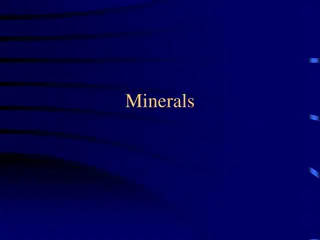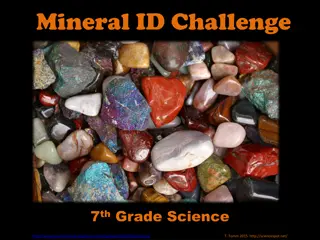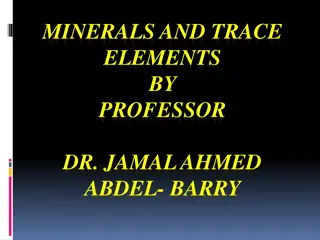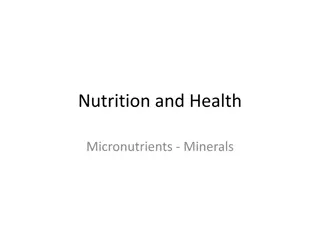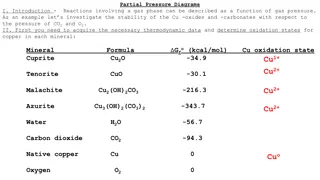Understanding Minerals: Properties and Identification
Minerals are naturally occurring solid inorganic substances with definite compositions and structures. They are classified based on physical and chemical properties. This content discusses the definition of minerals, the conditions that classify gold as a mineral, distinguishing mineral characteristics, reliable identification methods like luster and hardness, Mohs scale of hardness, fracture and cleavage, and the significance of color in mineral identification.
Download Presentation

Please find below an Image/Link to download the presentation.
The content on the website is provided AS IS for your information and personal use only. It may not be sold, licensed, or shared on other websites without obtaining consent from the author. Download presentation by click this link. If you encounter any issues during the download, it is possible that the publisher has removed the file from their server.
E N D
Presentation Transcript
Do Now What is a mineral? 10
Minerals Minerals are Naturally occurring Solid Inorganic Definite composition Definite structure Minerals are classified on the basis of their physical and chemical properties
Is oil a mineral? No oil is a liquid Is coquina a mineral? No organic (Limestone) Is gold a mineral? Yes it meets the 5 conditions
Distinguishing Characteristics of Minerals From the ESRT Luster Hardness Cleavage/fracture Common colors Streak
Reliable Means of Identification Luster is the way a mineral reflects light. We use two: Metallic shines like polished metals Nonmetallic have no metallic shine There are different nonmetallic lusters Glassy, waxy, pearly, dull
Hardness Resistance to being scratched Mohs scale of hardness Hardness if found by scratching other minerals
Mohs Scale of Hardness 1- Talc 2 Gypsum 3 Calcite 4 Fluorite 5 Apatite 6 - Feldspar 7 - Quartz 8 - Topaz 9 - Corundum 10 - Diamond
Scratch test Copper 3.5 Glass 5.5
Fracture and Cleavage refer to the way a mineral breaks Fracture Rough, uneven break Cleavage Smooth flat break The mineral breaks at specific angles if it has cleavage Many minerals break along flat surfaces called cleavage planes. Cleavage planes are not always parallel to the sides of the crystals
Color is the most visible property of a mineral. It is unreliable for two reasons Many different minerals have the same color Many minerals have a variety of colors
Streak is the color of a mineral in its powdered form. It is a reliable tool to identify minerals It is found using a streak plate. A streak plate is an unglazed white porcelain plate
Do Now 1. What is a mineral?
Other ways to identify minerals Color Many minerals have a distinct color Sulfur, Pyrite Most minerals have a varied color Quartz, calcite Color is the least reliable way to identify a mineral
Chemical means Calcite and Dolomite react (bubble) with acid Radioactivity uranium Sunstone Double refraction calcite Magnetism - magnetite
Density Density is a constant for all minerals Most minerals have a density of 2.5 g/cm3 to 3.5 g/cm3 Gold has a density of 19 g/cm3 Lead has a density of 12 g/cm3
Specific Gravity is the density of a mineral divided by the density of water The specific gravity of gold is: the density of gold 19g/cm3 divide by the density of water 1g/cm3 19g/cm3/1 g/cm3= 19 (no units) The specific gravity of gold is 19
What is a mineral with a hardness of 2.5 and a streak? Galena What is a mineral that scratches Calcite but not Pyroxene? Dolomite or Fluorite What is a mineral that scratches talc but not calcite and has a streak? Sulfur or gelena What determines the streak of gelena? Internal arrangement of atoms
The physical and chemical properties of minerals are determined by the internal arrangement of the atoms
Minerals 19 Nov 2019
Do Now 1. What is a mineral? 2. What is cleavage? 3. What is hardness? Get out Homework Next homework due Wednesday 20 Nov 2019 Naturally occurring, inorganic, solid with definite composition and structure Cleavage is a break with one or more smooth flat surfaces The resistance to being scratched
Do Now 1. The distance from the entrance to Saunders and Briggs Ave is 27 m. The change in elevation is 9 m. What is the gradient? 2. The Cross County rises 20 meters during its 5 km length. What is its gradient? 3. What is a Rock? 4. Get out ESRT 5. H/W worksheet due Tuesday, 19 Nov 2019 G= FV/D= 9m/27m=.33m/m G= FV/D=20m/5 km= 4m/km a mass of stone
Other unusual properties Calcite double refraction Viking used this to navigate Uranium radioactive Magnetite magnetic Some minerals bubble with acid (Regents loves these) Calcite and Dolomite Some minerals smell Sulfur and olivine Taste test Halite - salt If you do a taste test you will get a zero
How do we identify minerals? By their physical and chemical properties What determines the properties of minerals? Internal arrangement of atoms
What is a mineral that scratches Dolomite but not Orthoclase? m 1. Halite 3. Fluorite 4. Quartz 3. Fluorite What are the two minerals made up of only one type of atom? Graphite and Sulfur 2. Pyrite
What is a mineral with a scratches talc but not calcite and has a black streak? Galena What mineral is an iron ore and has a reddish brown streak? m 1. Magnetite 2. Hematite Galena 4. Dolomite 2. Hematite 3.
What is a mineral with fracture that will scratch Quartz? m 1. Galena 2. Amphibole . Pyrite 4. Garnet 4. Garnet What is a mineral that does not scratch calcite and cleavage? m 1. Sulfur 2. Magnetite Halite 4. Dolomite 3. Halite What is a mineral with a hardness more than 5, a green streak and fracture? Pyrite 3 3.
